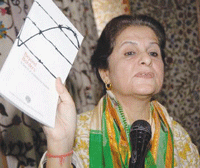The south-western seaboard state of Kerala (pop. 32 million), currently being ruled by a CPM (Communist Party Marxist)-led coalition government, has been displaced from its traditional top position on the podium as India’s most well-educated state.
In its latest Educational Development Index (EDI) 2007-08 released on January 17, the Delhi-based National University of Educational Planning and Administration (NUEPA) ranks Puducherry (pop. 0.5 million) numero uno with an EDI value of 0.808 (out of a maximum 1), pushing Kerala (0.791) to second position. These states are followed by Lakshadweep (0.788), Delhi (0.780) and Tamil Nadu (0.771). Compiled annually, EDI measures the primary and upper primary education attainments of India’s 29 states and five Union terri-tories. Bihar (0.406), Arunachal Pradesh (0.485), West Bengal (0.488), Jharkhand (0.491), and Assam (0.515) are the most laggard states educationally.
But even as the flash statistics of NUEPA indicate a marginal across-the-board improvement in primary education countrywide, its conclusions are contradicted by another report — Status of India’s Children 2009, released on January 23 by the Delhi-based child rights advocacy organi-sation HAQ. SIC 2009, based on literature reviewed from various sources, says that over six million children living in India’s proliferating urban slums seldom get basic services, highlighting that India ranks 66th among 88 countries in the Global Hunger Index, below 25 countries in Africa’s poor sub-Saharan region.
According to HAQ (estb. 1998), 75 percent of children in the age group 0-6 years don’t receive supplementary nutrition and a vast number of children of prostitutes, prisoners, and children with special needs, those affected by riots, militancy, natural disaster, and the displaced and orphaned continue to be out of the purview of childhood education. “Despite constitutional guarantees and legal provisions, children continue to be discriminated on the basis of caste, ethnicity and gender. Children with disabilities are excluded from mainstream education and other basic services that should be available to all children,” says the report.
“Children are important national assets and we have to act fast in the next five years and speak up for them. If we don’t, there will be a crisis of great proportions,” warns Ravi Prakash Varma, member of Parliament representing the Kheri constituency of Uttar Pradesh, who focuses on social issues such as education, women and child development, and has been re-elected to the Lok Sabha three times by his grateful constituency.
Belatedly, New Delhi’s somnolent establishment is becoming aware of the long-festering crisis in Indian education. Educationists and children’s champions tend to draw some comfort from the provisions made for primary and secondary education in the Eleventh Plan (2007-12).
In particular, the Rashtriya Madhyamik Shiksha Abhiyan (RMSA), a Central government initiative to universalise access to and improve quality of secondary education, for which a provision of Rs.20,120 crore has been made, has cheered educationists. RMSA aims to achieve a general enrollment ratio (GER) of 75 percent in classes IX-X during the Plan period by providing a secondary school within a reasonable distance of every habitation, and to universalise access to secondary education by 2017. To this end the Eleventh Plan document enumerates the strengthening of about 44,000 existing secondaries, inaugurating 11,188 new secondaries with 80,500 classrooms and appointment of 179,000 teachers.
 “I am happy that the Planning Commission’s initiative is being welcomed, which is imperative for its onward journey. Let me assure you that we’ve made a beginning in such a way that subsequent planners can’t ignore it, and it (education) will receive greater attention as we go along,” says Syeda Hameed, member of the Planning Commission.
“I am happy that the Planning Commission’s initiative is being welcomed, which is imperative for its onward journey. Let me assure you that we’ve made a beginning in such a way that subsequent planners can’t ignore it, and it (education) will receive greater attention as we go along,” says Syeda Hameed, member of the Planning Commission.
But even as educationists and child rights champions are celebrating the Delhi durbar’s belated interest in primary-secondary education, they should bear in mind that the Eleventh Plan document is a statement of intent. If all the targets set by the Planning Commission (estb. 1950) had been met, India would have been the contemporary world’s most developed and affluent nation.
Autar Nehru (Delhi)